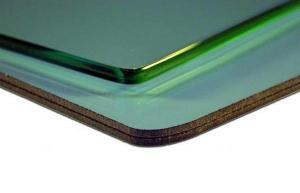Laminated Glass vs. Tempered Glass: What are the Similarities and Differences?

Tempered glass is by far the most common glass used in home construction. One of the apparent differences between laminated glass vs. tempered glass is their physical characteristic. They are both clear and tough glass, but laminated glass is made by fusing two sheets of ordinary annealed safety glass with a thin layer of PVB plastic. A metal mesh screen embedded in the PVB holds the layers together. It’s called laminated because it laminates to the glass.
What is tempered glass, and how does it differ from laminated glass?
Thanks to laminated glass, you can use it in applications where safety is a concern. On the other hand, Tempered glass offers increased protection over the laminated glass through an additional manufacturing step called tempering or heat strengthening, making the tempered glass stronger than laminated glass. This also contributes to making tempered glass five times more likely to survive an impact than laminated glass.
Related post: How To Tell If The Glass Is Tempered
Here are some other similarities and differences between tempered glass and laminated glass:
- Laminated glass provides the same safety and security as tempered glass while protecting against sound, heat, and water.
- Laminated glass is more flexible than tempered glass, but it has to be replaced if broken because once laminated layers are damaged, they cannot be fixed.
- Laminated glass is cheaper to replace in case of breakage than tempered glass.
- Laminated glass can withstand higher temperatures than tempered glass, which is why it’s used for oven doors and fireplaces.
- Laminated glass provides more excellent safety in burglary because its layers are difficult to separate without specialized tools. It also offers better protection against natural disasters like earthquakes where falling objects may hit people.
- Laminated glass is more difficult to break than tempered glass, but when it does, the broken pieces are much smaller and less sharp, which means they cause significant damage.
- Laminated glasses are made of two materials that protect the laminate’s inner surface against scratches and other damage. On the other hand, tempered glass comprises three layers; annealed plate window sheet, PVB interlayer sheet, and toughened outer pane sheet.
- Many people may wonder how to tell the difference between tempered vs laminated glass. Both types of glass look very much alike, and it is difficult for many people to tell them apart. However, the smooth edges of tempered glass can be easily identified, while laminated glass has rounded edges.
Related Article: All You Need To Know About Laminated Glass
What are the benefits of each type of glass?
The primary purposes of using tempered or laminated glass are protection, safety, and aesthetics. The surface of the glass is made to be stronger than the interior, allowing the exterior part of the glass to take all of the damage in case there is a breakage or shattering of any kind. This means that tempered and laminated glasses are safer and more reliable than regular or standard glass.
Tempered and laminated glass is used in many applications, especially for windows. For example, the windshield of any vehicle is made out of laminated glass. Additionally, skylights and other types of windows may be protected by either tempered or laminated glass.
Tempered glass is much stronger than standard glass, making it resistant to the effects of an impact or physical force. If tempered glass undergoes enough pressure, it will strengthen itself against the applied force.
Which should I use: Tempered or Laminated Glass?
Safety is one of the main reasons for using either tempered or laminated glass. Although both types of glass look very similar, laminated glass has a few advantages over standard or tempered glass. One of the primary purposes for using tempered or laminated glass is to prevent injuries and accidents that could otherwise occur, especially if the windows were not made out of protective material.
For example, if a child accidentally falls against a window and breaks it, the standard glass may cause grievous harm to the child because it often shatters into many sharp shards. However, if the window was made out of laminated glass instead, it is unlikely that the child would get hurt because it would break into small pieces and not into numerous jagged shards.
Additionally, it is also more difficult to break by forcibly applying pressure to either laminated or tempered windows than standard windows or even other types of glass. Both types of window glass are strong and more resistant to breaking due to their pressure.
Another scenario: suppose an individual is trying to break into a house by breaking through one of the windows. In that case, it will be tough for them to do so with laminated windows because they will not shatter into edge pieces like standard windows.
Related post: How To Tell If The Glass Is Tempered
Conclusion
In choosing between laminated glass vs. tempered glass, you have to remember that glass is a versatile material that can be used for an array of products. The makeup and composition of glass will determine what type it is and its properties and function.
If you’re looking for high-quality tempered safety glass, we, at One Day Glass, offer the best in custom cut and fabricated safety panels to fit your needs precisely with our state-of-the-art machinery. But, of course, we provide steel fabrication services too.
Call us for a free quotation at (800) 452-6117.
